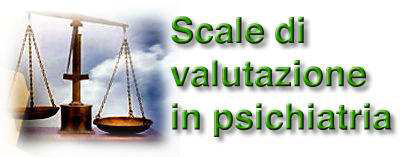 |
|
|
|
|

CAPITOLO 15 IL PAZIENTE PSICOGERIATRICO CONCLUSIONI La valutazione del paziente psicogeriatrico non è una cosa facile: lo dimostra ampiamente il fatto che sono stati messi a punto un numero notevole di strumenti; fra questi, quelli qui presentati sono soltanto una parte e neppure la più cospicua. Il problema fondamentale è che il deterioramento mentale è un fenomeno estremamente complesso, polimorfo, disomogeneo, in funzione di numerose variabili, fra le quali possiamo citare la "qualità" dello sviluppo del SNC nel corso della vita, la preponderanza o, rispettivamente, la meiopragia delle diverse aree anatomo-funzionali del SNC, le caratteristiche peculiari della patologia responsabile del deterioramento e le sue modalità evolutive e molte altre ancora. Ma a queste dobbiamo aggiungere anche che, in larga misura, il quadro clinico delle sindromi demenziali è ricco, articolato e variabile per una gran parte del decorso della malattia poiché risulta dal diverso e complesso articolarsi delle funzioni non ancora modificate dal processo morboso con quelle, invece, già più o meno completamente compromesse e con quelle, infine, elaborate ex novo in funzione di adattamento e di compenso ai mutamenti che mano a mano si verificano. Il demente, infatti, può mantenere a lungo una certa capacità intellettiva tale da consentirgli, sia pure in maniera progressivamente decrescente, di conservare la coscienza di sé e della propria identità, il controllo delle proprie azioni, la capacità di far fronte alle attività routinarie; egli dunque, facendo ricorso alle conoscenze acquisite più consolidate dall’uso, è in grado di opporsi efficacemente, per un tempo più o meno lungo, al progressivo ed ingravescente deterioramento mentale, anche se il progredire della malattia renderà sempre più fragile, incostante e parziale la capacità di mantenere il controllo sulle attività della vita quotidiana. È forse per questo che la valutazione del paziente può essere facile nelle fasi avanzate della malattia, quando il quadro psicopatologico, dopo un inizio ed un decorso variamente irregolare e singolare, tende verso una crescente omogenizzazione. Molto più difficile è nelle fasi iniziali, quando è più eterogeneo, ma quando è anche più importante coglierlo nella sua natura, gravità e complessità in modo da poter mettere in atto tutti gli interventi necessari per interromperne (o almeno rallentarne) l’evoluzione. Ed è proprio in questa fase iniziale che le nostre capacità di valutazione sono più limitate. Vogliamo augurarci che le informazioni fornite in questa sede possano rappresentare un’utile base di partenza per ulteriori fruttuosi sviluppi.
BIBLIOGRAFIA Akhtar AJ, Broë GA et al.: Disability and dependence in the elderly at home. Age Ageing, 2:102, 1973. Alexopoulos GS, Abrams RC et al.: Cornell Scale for Depression in Dementia. Biol Psychiat, 23:271,1988. Benton AL: Manuel pour l’Application du Test de Rétention Visuelle. Applications Cliniques et Expérimentales. 2ème édition française. Centre de Psychologie Appliquée, Paris, 1965. Blessed G, Tomlinson BE, Roth M: The association between quantitative measures of dementia and of senile change in the cerebral grey matter of elderly subjects. Br J Psychiat, 114:797, 1968. Bond J, Brooks P et al.: The reliability of a Survey Psychiatric Assessment Schedule for the elderly. Br J Psychiat, 137:148, 1980. Brazzelli M, Capitani E et al.: A neuropsychological instrument adding to description of patients with suspected cortical dementia: the Milan Overall Dementia Assessment. Neurol Neurosurg Psychiat, 57:1510, 1994. Brink TL, Yesavage JA et al.: Screening test for geriatric depression. Clin Geront, 1:37, 1982. Caltagirone C, Perri R: Le Scale di Valutazione nella Malattia di Alzheimer. Emme edizioni, Milano, 1998. Center for the Study of Aging and Human Development - Duke University: Multidimensional Functional Assessment: The OARS Methodology. Duke University: Center for the Study of Aging and Human Development, 1978. Conti L: Le Scale di Valutazione in Psichiatria. Schizofrenia e altri Disturbi Psichici. Adattamento Sociale. Digest Neuropsichiatria, Utet, Milano, 1996. Conti L, Ruggeri M, Faravelli C: Strumenti di valutazione e di misura. In: GB Cassano et al. (Eds.) "Trattato Italiano di Psichiatria", Masson, Milano, 1993. Conti L, Scarone S et al.: Demenze. In: GB Cassano et al. (Eds.) "Trattato Italiano di Psichiatria", Masson, Milano, 1993. Copeland JRM, Kelleher MJ et al.: A semi-structured clinical interview for the assessment of diagnosis and mental state in the elderly: the Geriatric Mental State Schedule. I: Development and reliability. Psychol Med, 6:439, 1976. Crum RM, Anthony JC et al.: Population-based norms for the Mini-Mental State Examination by age and educational level. JAMA, 18:2386, 1993. Ferm L: Behavioural activities in demented geriatric patients: a study based on evaluations made by nursing staff members and on patients’ scores on a simple psychometric test. Geront Clin, 16:185, 1974. Fishback DB: Mental Status Questionnaire for organic brain syndrome, with a new visual counting test. J Am Geriat Soc, 25:167, 1977. Folstein MF, Folstein SE, McHugh PR: "Mini-Mental State": a practical method for grading the cognitive state of patients for the clinician. J Psychiat Res, 12:189, 1975. Georges D, Lallemand A et al.: Validation par l’analyse factorielle d’une échelle d’évaluation clinique des troubles de la sénescence cérébrale. Application à l’essai thérapeutique. Thérapie, 32:173, 1977. Goldfarb AI: The evaluation of geriatric patients following treatment. In: P Hoch e J Zubin (Eds.) "The Evaluation of Psychiatric Treatment", Grune e Stratton, New York, 1964. Götestam KG: A Geriatric Rating Scale empirically derived from three rating scales for geriatric behaviour. Acta Psychiat Scand, 294 (s): 54, 1981. Gottfries CG, Brane G, Steen G: A new rating scale for dementia syndromes. Gerontology, 28(s):20, 1982. Greene JG, Smith R et al.: Measuring behavioural disturbance of elderly demented patients in the community and its effects on relatives: a factor analytic study. Age Ageing, 11:121, 1982. Gurland BJ, Fleiss JL et al.: A semi-structured clinical interview for the assessment of diagnosis and mental state in the elderly: the Geriatric Mental State Schedule. I: Development and reliability. Psychol Med, 6:451, 1976. Gurland BJ, Kuriansky J et al.: The Comprehensive Assessment an Referral Evaluation (CARE): rationale, development and reliability. Int J Aging Human Devel, 8:9, 1977-78. Hachinski VE, Iliff LD et al.: Cerebral blood flow in dementia. Arch Neurol, 32:632, 1975. Hughes C, Berg L et al.: A new clinical scale for the staging of dementia. Brit J Psychiat, 140:566,1982. Israël L, Kozarevic D, Sartorius N: Evaluations en Gérontologie. Karger, Basel, 1984. Israël L, Ohlmann T, Chappaz M: Batterie psychométrique à l’usage du médecin généraliste pour apprécier les conduites intellectuelles del personnes âgées. Psychol Méd, 12:921, 1980. Kahn RL, Goldfarb AI et al.: Brief objective measures for the determination of mental status in the aged. Am J Psychiatry, 117:326, 1960. Katz S, Ford AB et al.: Studies of illness in the aged - The index of ADL. JAMA, 185:94, 1963. Katzman R, Rowe J: Principles of Geriatric Neurology. FA Davis, Philadelphia, 1992. Knopman DS, Knapp MJ et al.: The Clinician Interview-Based Impression (CIBI): a clinician’s global change rating scale in Alzheimer’s disease. Neurology, 44:2315, 1994. Kuriansky J, Gurland B: The Performance Test of Activities of Daily Living. Int J Aging Human Development, 7:343, 1976. Lawton MP: The Philadelphia Geriatric Center Morale Scale: A revision. J Gerontology, 30:85, 1975. Lawton MP, Brody EM: Assessment of older people: self-maintaining and instrumental activities of daily living. Gerontologist, 9:179, 1969. Lawton MP, Moss M et al.: A research and service-oriented Multilevel Assessment Instrument. J Gerontol, 37:91, 1982. Linn MW, Sculthorpe WB et al.: A Social Dysfunction Rating Scale. J Psychiat Res, 6:299, 1969. Loeb C., Gandolfo C.: Diagnostic evaluation of degenerative and vascular dementia. Stroke, 14:399, 1983. Logsdon R, Teri L: Depression in Alzheimer’s disease patients: caregivers as surrogate reporters. J Am Geriat Soc, 43:150, 1995. Mattis S: Dementia rating scale. In: R Bellak, B Karasu (Eds.) "Geriatric Psychiatry", Grune & Stratton, New York, 1976. Meer B, Baker JA: The Stockton Geriatric Rating Scale. J Gerontol, 21:392, 1966. Miller ER, Parachek JF: Validation and standardization of a goal-oriented, quick screening geriatric scale. J Am Geriat Soc, 22:278, 1974. Murkofsky C, Conte H et al.: Clinical utility of a rapid diagnostic test series for elderly psychiatric outpatients. J Am Geriat Soc, 26:22, 1978. Palma A, Pancheri P: Scale di valutazione e di misura dei sintomi psichiatrici. In: Pancheri P, Cassano GB et al. (Eds.) "Trattato Italiano di Psichiatria", Seconda edizione, Masson Italia, Milano, 1999. Parnetti L, Gottfries CG et al.: La scala GBS per la valutazione delle demenze: studio della interrater reliability della versione italiana. Giorn Geront, 37:293, 1989. Pattie AH, Gillard CJ: Manual of the Assessment Procedures for the Elderly (C.A.P.E.). Hodder and Stoughton, Kent, 1979. Pfeiffer E: A Short Portable Mental Status Questionnaire for the assessment of organic brain deficit in elderly patients. J Am Geriat Soc, 23:433, 1975. Pfeiffer E: A Short Psychiatric Evaluation Schedule: A New 15-item Monotonic Scale Indicative of Functional Psychiatric Disorder. Bayer Symposium VII, Springer-Verlag, Berlin, 1979. Pierce RC, Clark MM: Measurement of Morale in the Elderly. Int J Aging Human Development, 4:83, 1973. Plutchik R, Conte H et al.: Reliability and validity of a scale for assessing the functioning of geriatric patients. J Am Geriat Soc, 18:491, 1970. Raskin A, Rae DS: Psychiatric symptoms in the elderly. Psychopharm Bull, 17:96, 1981 Reisberg B, Ferris S et al.: The Global Deterioration Scale for the assessment of primary progressive dementia. Am J Psychiatry, 139:1136, 1982. Roth M, Tym E et al.: CAMDEX. A standardized instrument for the diagnosis of mental disorders in the elderly with special reference to the early detection of dementia. Br J Psychiatry, 149:698, 1986. Rosen WG, Mohs R, Davis K: A new rating scale for Alzheimer disease. Am J Psychiatry, 141:698, 1984. Shader RI, Harmatz JS, Salzman C: A new scale for clinical assessment in geriatric populations: Sandoz Clinical Assessment Geriatric (SCAG). J Am Geriat Soc, 22:107, 1974. Spitzer RL, Fleiss JL et al.: The Mental Status Schedule: Rationale, reliability and validity. Compreh Psichiat, 5:384, 1964. Sunderland T, Alterman IS et al.: A new scale for the assessment of depression mood in demented people. Am J Psychiatry, 145:955, 1988. Wechsler D: Échelle d’Intelligence de Wechsler pour Adultes: WAIS. 2ème édition. Centre de Psychologie Appliquée, Paris, 1970. Wells CE: Pseudodementia. Am J Psychiatry, 136: 895, 1979. Wing JK, Cooper JE, Sartorius N: Measurement and Classification of Psychiatric Symptoms: An Instruction Manual for the PSE and CATEGO Program. Cambridge Univ. Press, London, 1974. World Health Organization: Disability Assessment Schedule (DAS). WHO, Geneve, 1979. Yessavage JA, Adey H, Werner PD: Development of a geriatric behavioral self-assessment scale. J Am Ger Soc, 29:285, 1981. Zarit JM, Zarit SH: The Memory and Behavior Problems Checklist and the Burden Interview. (Pennsylvania State University, Gerontology Center Reprint Series No 189, part 3). College Park, PA, Pennsylvania University Gerontology Center, 1990. , Zaudig M, Mittelhammer J, Hiller W.: Structured Interview for the Diagnosis of Dementia of the Alzheimer Type, Multiinfarct Dementia and Dementias of Other Aetiology According to ICD-10 and DSM-III-R. Logomed, Munich, 1989. Zaudig M, Mittelhammer J et al.: SIDAM: A Structured Interwiew for the diagnosis of Dementia of the Alzheimer type, Multiinfarct dementia and dementias of other aetiology according to ICD-10 and DSM-III-R. Psychol Med, 21:225, 1991. |
TORNA ALL'INDICE GENERALE "SPECIALE SCALE DI VALUTAZIONE" POL.it è organizzata per rubriche e sezioni affidate a Redattori volontari che coordinano le varie parti della Rivista. Anche tu puoi divenare collaboratore fisso o saltuario della testata, scrivi utlizzando il link proposto sottto, dando la tua disponibilità in termini di tempo e di interessi, verrai immediatamente contattato. Come tante realtà sulla rete POL.it si basa sul lavoro cooperativo ed è sempre alla ricerca di nuovi collaboratori, certi come siamo che solo un allargamento della cerchia dei suoi redattori può garantire alla Rivista la sua continua crescita in termini di contenuti e qualità. ti aspettiamo..... |
![]()
![]()





